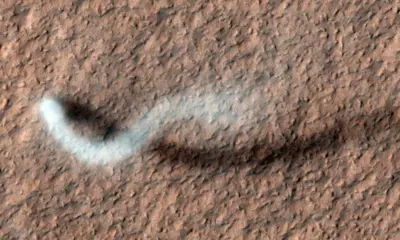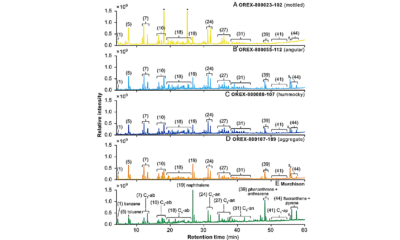Science
Astronomer Claims Breakthrough in Dark Matter Research with New Findings

Astronomers may be one step closer to understanding dark matter, a mysterious substance believed to be fundamental in holding galaxies together. A recent study led by Tomonori Totani, an astronomer at the University of Tokyo, claims to have identified gamma-ray emissions that suggest a potential breakthrough in dark matter detection. The findings, published on October 3, 2023, in the Journal of Cosmology and Astroparticle Physics, indicate these emissions may have originated from colliding weakly interacting massive particles (WIMPs), a leading candidate for dark matter.
Totani utilized data from NASA’s Fermi Gamma-ray Space Telescope, analyzing observations gathered over a span of 15 years. In his research, he focused on the halo region of the Milky Way, rather than the galactic center where most searches have traditionally been concentrated. “This time, I have discovered gamma-ray emissions believed to originate from dark matter,” Totani explained in an email to Gizmodo.
While the findings are promising, experts remain skeptical. They caution that the signals detected could simply be cosmic noise rather than a definitive sign of dark matter. Totani himself acknowledges the need for further verification, stating that it is too early to conclusively link the gamma rays to dark matter. “At the very least, it represents the most promising candidate radiation from dark matter known to date,” he remarked.
Understanding Dark Matter’s Role
The concept of dark matter has puzzled scientists for decades. It is theorized to account for the gravitational effects observed in galaxies that cannot be explained by visible matter alone. For instance, galaxies rotate at speeds that suggest they contain much more mass than can be seen, leading to the hypothesis that dark matter is present in significant quantities.
WIMPs are theorized to interact only through gravity and weak nuclear forces, making them incredibly difficult to detect. They are expected to annihilate upon collision, releasing gamma rays in the process—something astronomers have actively searched for. Previous efforts have focused primarily on the galactic center, where dark matter is thought to be densely concentrated. In contrast, Totani’s approach to examining the halo region represents a shift in strategy.
By analyzing high-energy gamma-ray emissions in this area, Totani found patterns that match theoretical predictions for emissions resulting from WIMP annihilation. The intensity and frequency of these emissions align with what scientists expect to observe if dark matter exists.
Challenges and Skepticism in Dark Matter Research
Despite the excitement surrounding Totani’s findings, other experts caution against jumping to conclusions. According to a physicist from Fermilab, there are numerous sources of gamma rays in the universe, including pulsars and supernovae, which could account for the signals detected. “There are very highly energetic things in space, and those highly energetic things can make high-energy gamma rays,” the physicist noted.
The emissions Totani reported are indeed energetic, with a photon energy of 20 gigaelectronvolts. While this is significant, it does not eliminate the possibility of alternative explanations. Other phenomena, such as neutron star collisions or solar activity, could also produce similar gamma rays.
As Totani himself pointed out, further studies will be essential to validate these observations. “The decisive proof will be the detection of gamma rays from other regions of the sky with the same dark matter parameters,” he stated. Independent verification of these results by other researchers will be crucial in determining the validity of his claims.
Dan Hooper, a professor of physics at the University of Wisconsin-Madison, expressed his reservations about the findings. He pointed out that previous analyses of the same Fermi data did not yield the excess gamma-ray emissions Totani reported. “Now, some different choices were made, and I’m glad people are trying different things, but it doesn’t leave me very confident that this is an authentic signal of dark matter,” he said.
The ongoing search for dark matter continues to challenge scientists, highlighting the complexity of the universe’s unseen components. Whether Totani’s claims will stand up to scrutiny remains to be seen. Regardless of the outcome, this research contributes to the broader understanding of dark matter and its potential role in the cosmos.
-

 Technology4 months ago
Technology4 months agoDiscover the Top 10 Calorie Counting Apps of 2025
-

 Health2 months ago
Health2 months agoBella Hadid Shares Health Update After Treatment for Lyme Disease
-

 Health3 months ago
Health3 months agoErin Bates Shares Recovery Update Following Sepsis Complications
-

 Technology4 weeks ago
Technology4 weeks agoDiscover 2025’s Top GPUs for Exceptional 4K Gaming Performance
-

 Technology2 months ago
Technology2 months agoElectric Moto Influencer Surronster Arrested in Tijuana
-

 Technology4 months ago
Technology4 months agoDiscover How to Reverse Image Search Using ChatGPT Effortlessly
-

 Technology4 months ago
Technology4 months agoMeta Initiates $60B AI Data Center Expansion, Starting in Ohio
-

 Technology4 months ago
Technology4 months agoRecovering a Suspended TikTok Account: A Step-by-Step Guide
-

 Health4 months ago
Health4 months agoTested: Rab Firewall Mountain Jacket Survives Harsh Conditions
-

 Lifestyle4 months ago
Lifestyle4 months agoBelton Family Reunites After Daughter Survives Hill Country Floods
-

 Technology3 months ago
Technology3 months agoUncovering the Top Five Most Challenging Motorcycles to Ride
-

 Technology4 months ago
Technology4 months agoHarmonic Launches AI Chatbot App to Transform Mathematical Reasoning





















